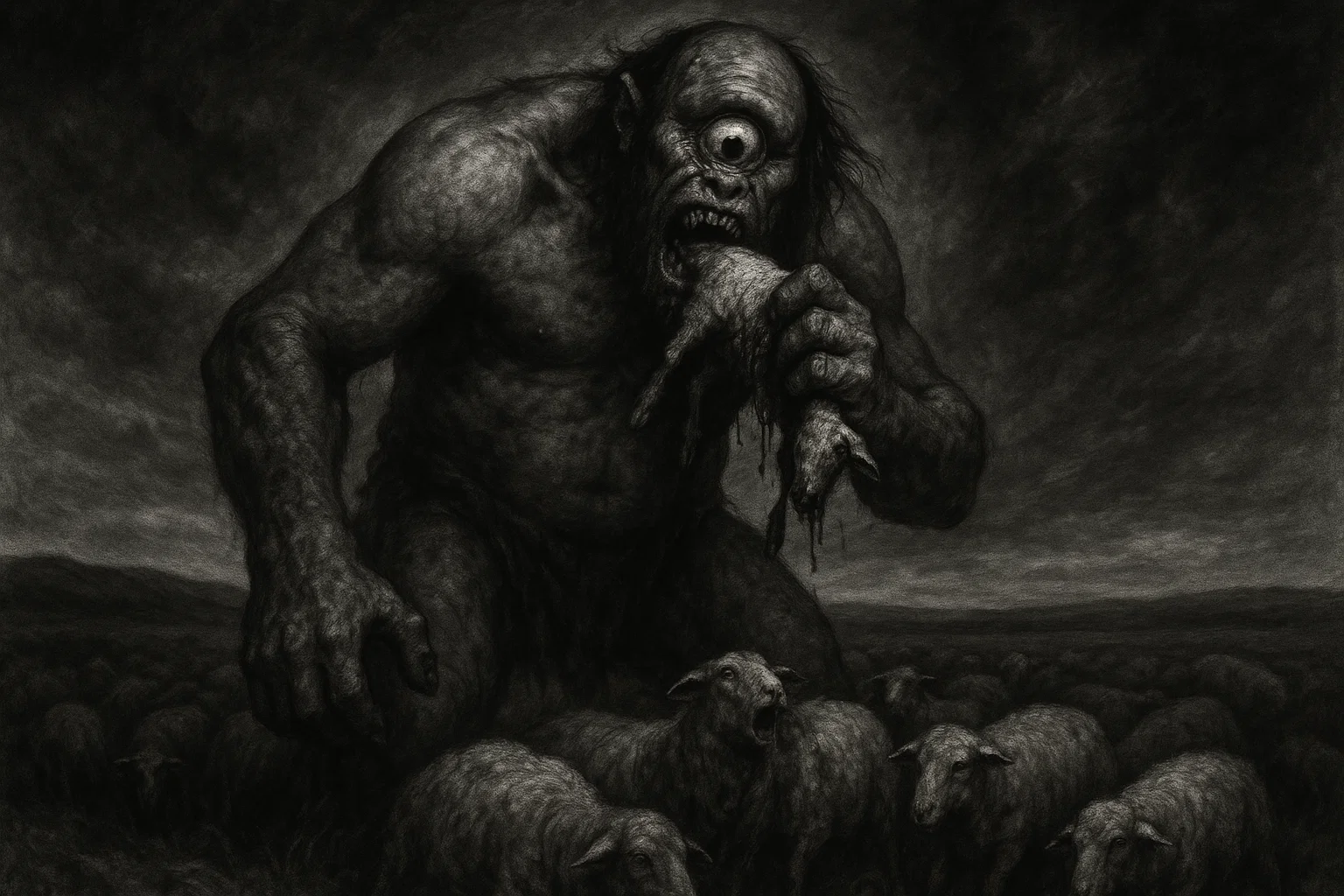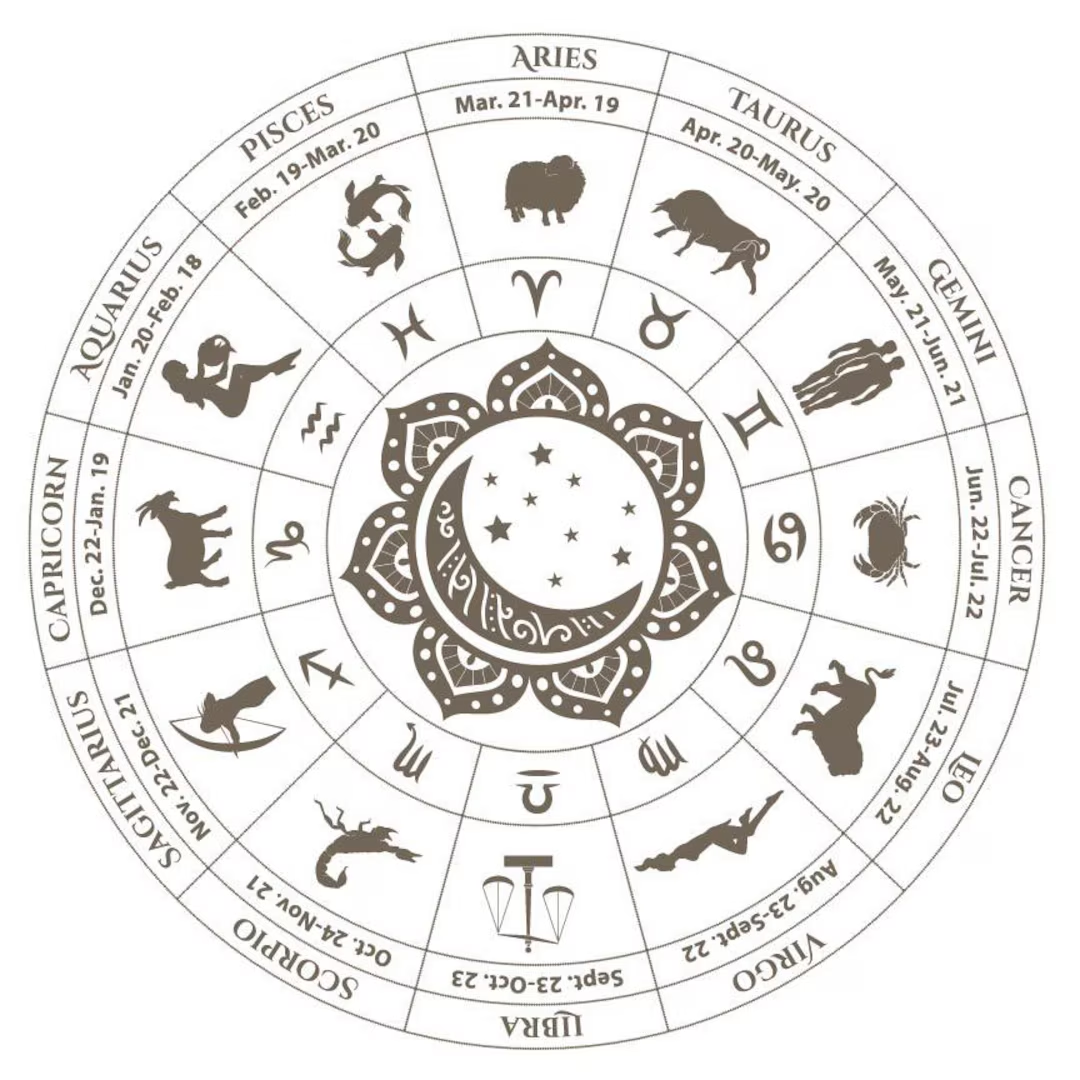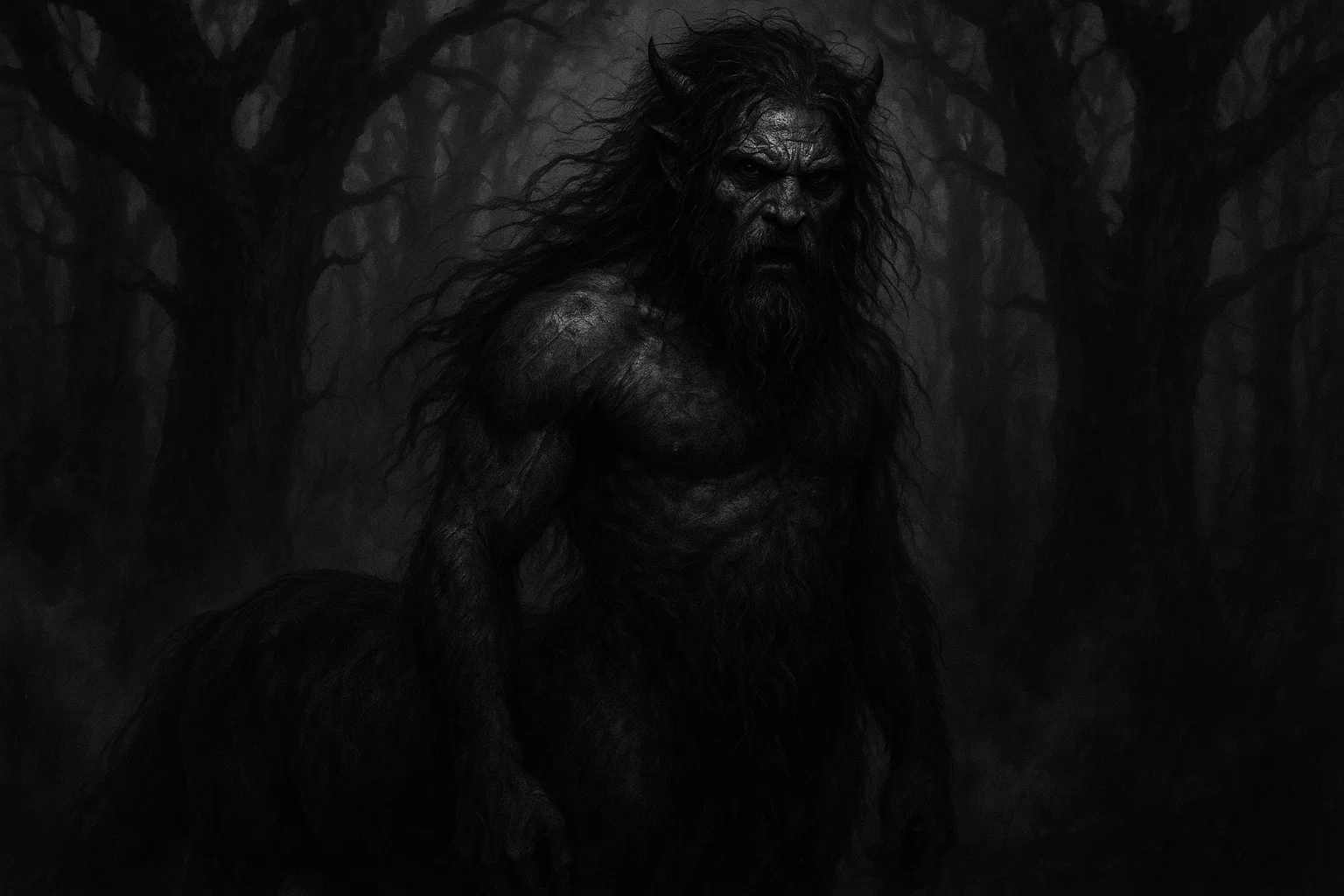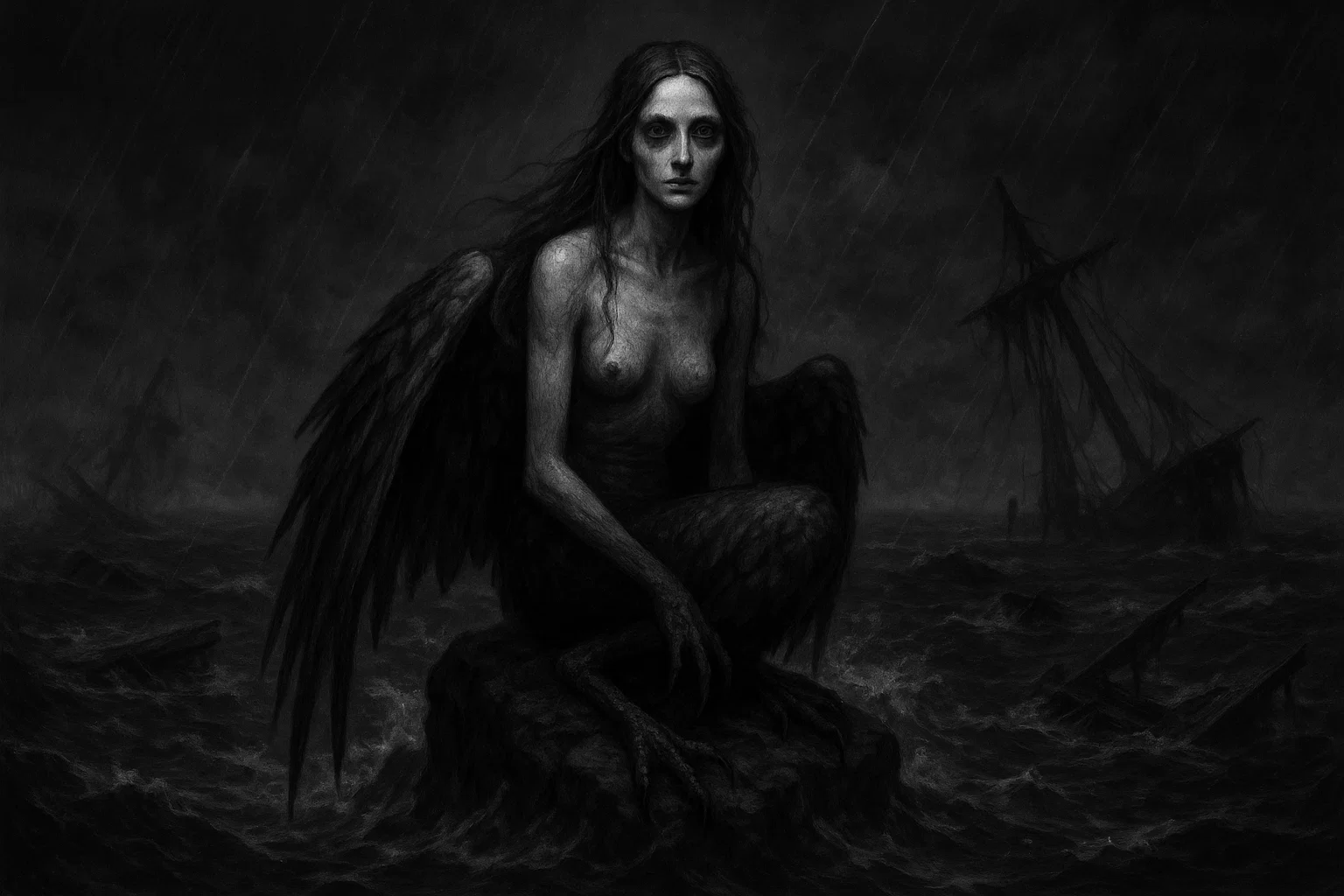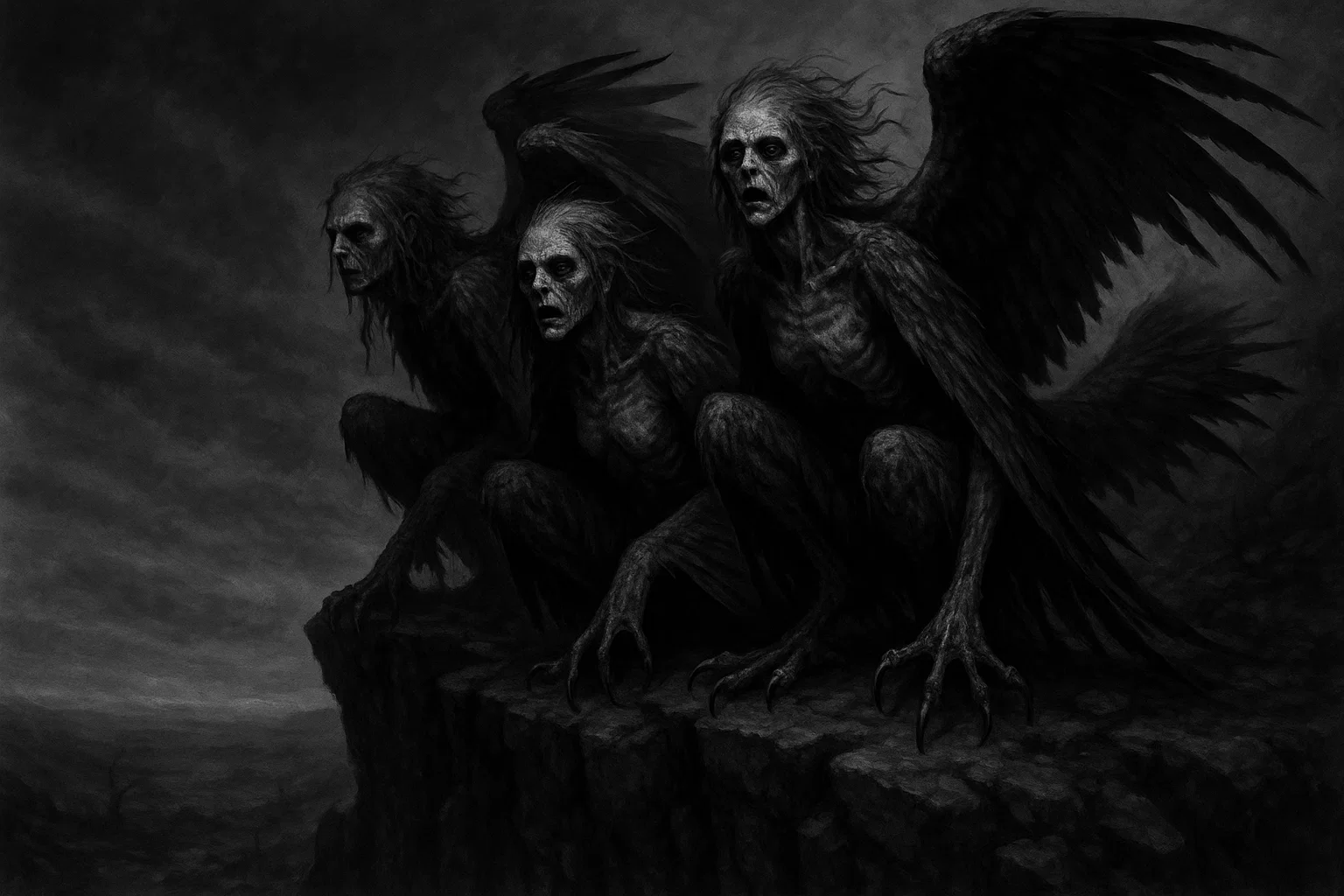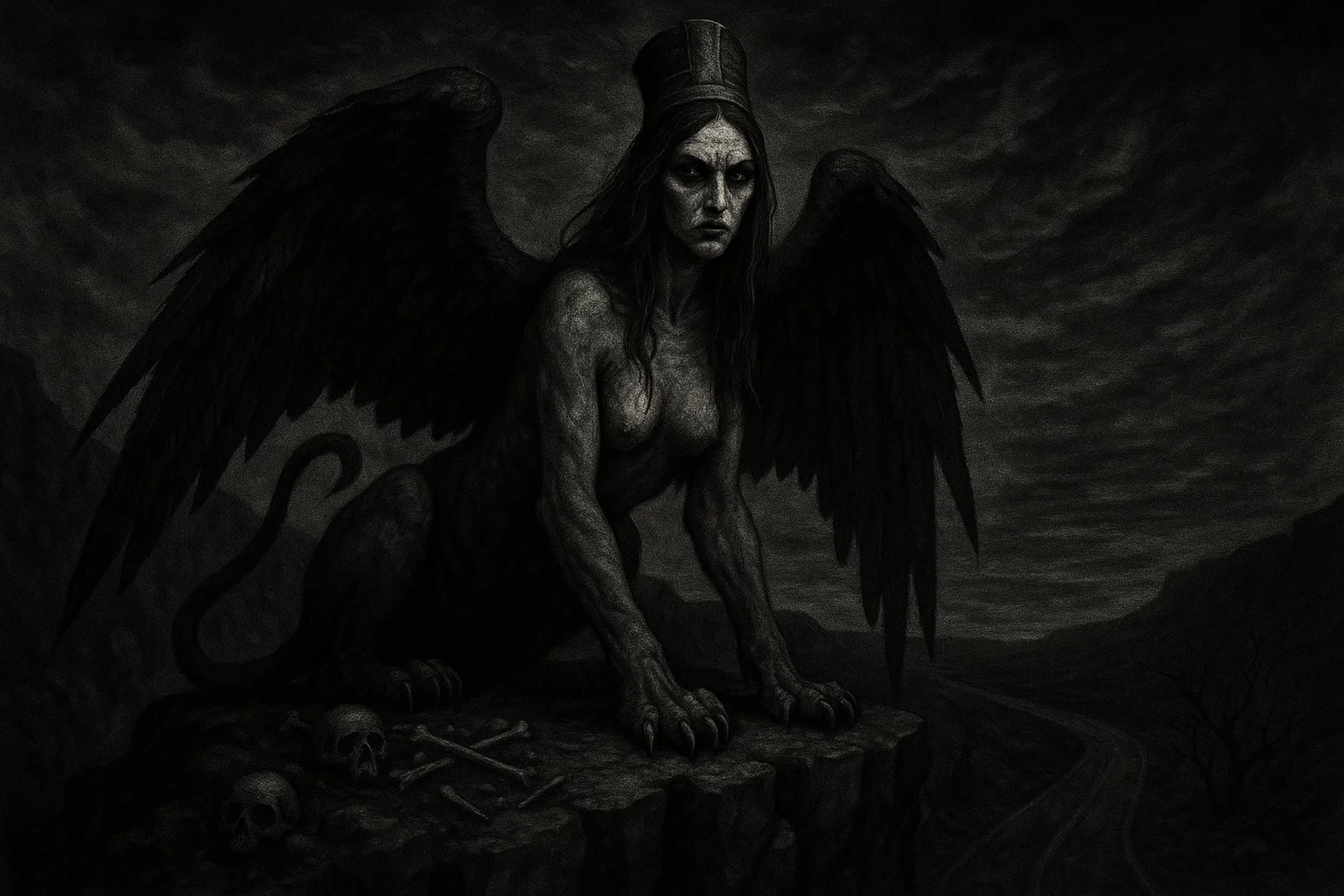The Cyclops refers to a race of one-eyed giants in Greek mythology, known for their immense size and strength. These beings appear in various forms across ancient texts, ranging from skilled craftsmen who forged weapons for the gods to savage shepherds who devoured humans.
The term encompasses multiple groups, including the primordial sons of Uranus and Gaia, a lawless tribe encountered by Odysseus, and builders of massive stone walls in Mycenaean cities.
In early accounts, the Cyclops played pivotal roles in the succession of divine rulers, aiding Zeus against the Titans by creating thunderbolts. Later traditions depict them as isolated figures living in caves on remote islands (like Sicily), rejecting societal norms and agriculture.
Their single eye, centered on the forehead, marks them as distinct from other giants, symbolizing both raw power and vulnerability.
Summary
Key Takeaways
| Attribute | Details |
|---|---|
| Names | Cyclops (singular), Cyclopes (plural); alternatives include Kyklopes; derived from Greek kuklos (“circle”) and ops (“eye”), meaning “circle-eyed” or “round-eyed.” |
| Nature | Supernatural giants; classified as primordial deities, monstrous shepherds, or divine artisans. |
| Species | Humanoid giants. |
| Appearance | Towering stature, single large eye in forehead center, muscular build; often depicted with wild hair and rough skin. |
| Area | Primarily ancient Greece, Sicily, and Mediterranean islands; associated with volcanic regions like Mount Etna. |
| Creation | Born as offspring of Uranus (Sky) and Gaia (Earth) for the elder group; later generations sired by Poseidon and sea nymphs. |
| Weaknesses | Blinding the single eye renders them helpless; vulnerable to cunning tactics and divine retribution. |
| First Known | 8th-7th century BCE, Hesiod’s Theogony. |
| Myth Origin | Rooted in Greek cosmogony and epic traditions; influenced by Indo-European motifs of one-eyed beings and ancient masonry. |
| Strengths | Immense physical power, expert craftsmanship in forging weapons; storm associations for elder Cyclopes. |
| Lifespan | Immortal for primordial Cyclopes; mortal for Homeric variants. |
| Diet | Sheep and dairy for shepherds; human flesh for cannibalistic types like Polyphemus. |
| Habitat | Caves in rugged mountains or islands; forges under volcanoes for smiths. |
Who or What Is a Cyclops?
The Cyclops is one of the giants of Greek lore, defined by its solitary eye and colossal form. These entities can be divided into distinct lineages.
The elder Cyclops (such as Brontes, Steropes, and Arges) appear as sons of the primordial deities Uranus and Gaia, embodying forces of nature through their ties to thunder and lightning.
Initially imprisoned by their father out of fear of their might, they later align with Zeus, demonstrating their role as indispensable allies in cosmic conflicts.
In contrast, the Homeric Cyclopes represent a more brutish archetype, as seen in the tribe of shepherds inhabiting Sicily’s distant shores. These beings shun laws, agriculture, and communal bonds, relying instead on the earth’s unlabored bounty and their flocks.
Polyphemus, the most notorious among them, exemplifies this group’s savagery, trapping intruders in his cavern and consuming them without regard for hospitality rites. Such Cyclops live in isolation, each ruling a familial cave with unchecked authority, their existence a stark counterpoint to ordered society.
Your Personalized, Hyper Accurate Moon & Astrology Reading
Limited time offer: Get your FREE, fully personalized Moon & Astrology Reading that takes astrology to a whole new level. Discover the secret depths of your personality, relationships, and true purpose in life.
Etymology
The name Cyclops derives from the Ancient Greek Kúklōps, a compound term that ancient sources consistently interpret as “circle-eyed” or “round-eyed.” This etymology traces to kúklos, meaning “circle” or “wheel,” combined with ops, denoting “eye” or “face.”
Hesiod, in his Theogony from the 8th-7th century BCE, explicitly links the appellation to the creatures’ physical trait: a single, orb-shaped eye centered on the forehead, evoking a circular form distinct from the paired eyes of mortals and gods alike.
This straightforward derivation appears in early texts, where the Cyclop’s name reflects observable anatomy rather than abstract symbolism.
Adalbert Kuhn, a 19th-century philologist, expanded on Hesiod by suggesting solar imagery, proposing that kúklos evokes the sun’s wheel-like path, rendering the Cyclops as “sun-wheel-eyed” guardians of celestial fire.
Alternative theories challenge the ocular focus. Some scholars, drawing from Indo-European roots, connect the second element to kléptēs (“thief”), yielding “wheel-thief” or “cattle-thief.” This fits the Homeric Cyclops’ pastoral raids and lawless husbandry, portraying them as livestock marauders in Sicily’s wilds.
Proto-Indo-European *wel- (“to turn”) or *pḱu- (“cattle”) further supports this, suggesting the name originally denoted opportunistic herders before evolving into a monstrous descriptor.
In Mycenaean Linear B tablets from the 14th-13th centuries BCE, precursors to kuklos appear in administrative contexts, possibly denoting circular structures or tools, hinting at pre-mythic associations with masonry—the third Cyclop group credited with erecting Cyclopean walls at Tiryns and Mycenae.
By the Classical period, Roman adaptations (like Virgil’s Aeneid) retain the Cyclops, applying it to Sicilian forges under Etna and blending Greek origins with Italic forge cults.
You May Also Like: The Mare: The Nightmare Monster That Crushes Men in Their Sleep
What Does a Cyclops Look Like?
Ancient depictions of the Cyclops emphasize uniformity in their defining feature: a single, large eye positioned squarely in the center of the forehead, often described as round and piercing.
This eye dominates the face, framed by coarse, unkempt hair and a broad, brutish countenance. Their bodies are immense (typically 15 to 30 feet tall) with disproportionately large heads and torsos supported by thick, muscular limbs suited for labor or violence.
Hesiod portrays the elder Cyclops as god-like in form (except for the eye), their robust frames covered in simple tunics amid forge heat, skin weathered by volcanic glow.
Vase paintings from the 7th-6th centuries BCE depict them wielding hammers, their single gaze fixed, muscles rippling under sweat-slicked hides. In contrast, Homeric accounts render the shepherd Cyclops more feral: shaggy pelts cover barrel-chested torsos, legs like tree trunks end in callused feet, and hands grasp massive clubs or stones with ease.
Polyphemus, the archetype, appears in Odyssey-inspired art as barrel-shaped, his lone eye bulging amid a tangle of locks and a beard matted with meal remnants.
Roman mosaics and reliefs amplify this: reddish or olive skin tones evoke earth’s children. At the same time, the eye gleams with feral intensity or craftsman’s precision.
Mythology
The Cyclops appears in Greek mythology through two primary traditions: the cosmogonic accounts of Hesiod and the epic narratives of Homer, each establishing distinct lineages.
Earliest mentions appear in Hesiod’s Theogony (c. 700 BCE), where the elder Cyclops—Brontes (“Thunderer”), Steropes (“Lightener”), and Arges (“Bright”)—appear as primordial offspring of Gaia and Uranus.
Born alongside the Titans and Hecatoncheires, these giants possess a single eye and embody elemental fury. Uranus, fearing their strength, imprisons them in Tartarus’s depths, chaining them with their stormy siblings.
This act sows discord, prompting Gaia to arm Cronus with a sickle for Uranus’s castration, initiating the generational overthrow. Cronus, after seizing power, perpetuates the imprisonment, viewing the Cyclops as threats to his rule.
Zeus, during the Titanomachy, liberated them under Gaia’s counsel and slew the jailer Kampe in the process. Grateful, the trio forges Zeus’s thunderbolts, Poseidon’s trident, and Hades’s helm of darkness—implements decisive in the Olympians’ victory.
Post-war, they reside in volcanic forges, eternally crafting for the gods, their immortality affirmed until Apollo slays them in retribution for Asclepius’s death by thunderbolt.
Homer’s Odyssey (c. 725 BCE) introduces a mortal race of Cyclops, lawless shepherds living in Sicily’s far west. These beings reject Zeus’s authority, agriculture, and assemblies, each patriarch ruling a cave-bound family with rams and ewes.
Awaken XT is unlike anything you’ve ever tried before…
…it’s based off a closely guarded formula that’s said to be able to supercharge your pineal gland and help you access your untapped inner power. With it’s unique blend of extremely hard to source ingredients, Awaken XT helps support the healthy functioning of your pineal gland, as well as your other organs in your body.
Legends
The Imprisonment and Liberation of the Elder Cyclopes
In the beginning, the earth goddess Gaia had three powerful sons, the Cyclopes: Brontes, Steropes, and Arges. These giant beings had one eye each in the center of their foreheads. The Cyclopes were incredibly strong and skilled at creating things. Still, their father, Uranus, feared them because their power threatened his rule.
So, as soon as they were born, Uranus locked them away in a dark pit called Tartarus, far beneath the earth.
Gaia was heartbroken over her children’s imprisonment and decided to take action. She crafted a sharp sickle and called upon her son, Cronus, asking him to confront Uranus. Cronus listened to his mother and waited until Uranus returned to Gaia.
In a surprising attack, Cronus used the sickle to overpower Uranus and cut away his ability to create more children, throwing those parts into the sea. From the waves, the goddess Aphrodite was born.
However, Cronus inherited his father’s fear. Also, it imprisoned the Cyclopes, along with another group of powerful beings called the Hecatoncheires, to ensure they wouldn’t threaten him either.
Meanwhile, Rhea, Cronus’s wife, secretly gave birth to Zeus on the island of Crete to protect him from Cronus, who had a habit of swallowing his children.
When Zeus grew up, he gathered some allies, including a wise ocean goddess named Metis. She tricked Cronus into drinking a potion that made him throw up all the children he had swallowed: Hestia, Demeter, Hera, Hades, and Poseidon.
With his siblings freed, Zeus united them to fight against Cronus and the Titans in a great battle known as the Titanomachy, which lasted ten years.
Zeus even ventured to Tartarus to rescue the imprisoned Cyclopes. He fought and defeated a dragon-like creature named Kampe, the prison’s guardian, and freed the Cyclopes.
Grateful for their release, the Cyclopes forged powerful weapons for Zeus, including thunderbolts that crackled with energy, as well as a mighty trident for Poseidon and a special helmet for Hades that allowed him to become invisible.
Armed with these incredible weapons, Zeus and his siblings defeated the Titans, sending Cronus and the others back into Tartarus, where they would be watched over by the Hecatoncheires.
The Cyclopes then began a new life, serving the gods and tirelessly working in their forges.
You May Also Like: Was the Kraken Real? The Origins of a Norse Horror Legend
Odysseus and the Blinding of Polyphemus
Odysseus and his twelve ships, escaping from the island of the Lotus-Eaters, came across a tall coastline covered in trees and smoke. When they rowed to shore, they found no farms or ports, only steep cliffs and a cave by the sea filled with sheep and baby goats.
Twelve of Odysseus’s men went into the cave and discovered it stocked with cheeses, containers of milk, and pens holding young lambs. They started a fire, enjoyed a meal of cheese and milk, and waited for the cave’s owner to return.
As twilight set in, Polyphemus, the giant son of Poseidon, returned home with his herd of six hundred sheep. A remarkable figure, he gathered milk from his flock into buckets, made sure the baby lambs stayed with their mothers, and started a fire to cook dinner.
Spotting intruders, he seized two, dashed their brains against the floor, and devoured them raw, bones and all. The crew yelled; Odysseus rushed to them, hand on sword. However, he held back, fearing the stone door none could shift.
As dawn broke, Polyphemus, the giant Cyclops, killed two of his sheep for breakfast. He then rolled aside a heavy door made from an olive tree, let his flock out, and closed it again. Meanwhile, Odysseus, hiding in the cave, prepared for what was to come. He had saved some strong wine from Ismarus and sharpened a stick in the fire to use as a weapon.
When Polyphemus returned, Odysseus greeted him warmly, offering him some wine. The Cyclops drank it eagerly and asked for more, wanting to know who had given it to him. Odysseus cleverly responded, “My name is No-Man.”
Drunk and satisfied, Polyphemus promised to eat Odysseus, whom he thought was named No-Man, last. The giant soon passed out from the wine.
Seizing the moment, Odysseus heated the sharpened stake until it was red hot and, with the help of four of his men, poked it into the Cyclops’s eye, twisting it like a tool used by carpenters. Polyphemus yelled in pain, pulling the stake out, blood flowing from his eye.
Other Cyclops heard his cries and came rushing to check on him. When they asked what was wrong, he shouted that “No-Man” had blinded him. Confused, they told him that if the gods were punishing him, he should pray to Poseidon.
When morning came, Polyphemus checked his flock, feeling each sheep to see if any had escaped. Odysseus cleverly tied himself and his men under the biggest sheep, hiding them well. The giant thought along the sheep’s backs but didn’t check underneath. Finally, they made it to the ship, and Odysseus cut the ropes holding them.
As they rowed away, Odysseus couldn’t resist taunting Polyphemus, saying, “Cyclops, you ate my men in your cave; you will be punished by Zeus and the gods for your evil deeds.” Furious, Polyphemus hurled a large rock at them, nearly capsizing the boat, and threw another stone that forced them back to shore.
The crew rowed with all their might while Poseidon, angered by his son’s pain, later wrecked Odysseus’s ships. Still, Odysseus managed to escape, even as Polyphemus’s curse echoed around them on the waves.
You May Also Like: Minotaur: Half Man, Half Bull—The Monster Born of Divine Punishment
Apollo’s Vengeance on the Cyclopes
Asclepius, the son of Apollo, was known for his incredible healing abilities, able to bring the dying back to life with plants and magical words. This worried Zeus, the king of the gods, who feared that Asclepius was becoming too powerful.
In his anger, Zeus sent a thunderbolt to strike him down. Apollo was heartbroken and furious when he learned of his son’s fate and retaliated by harming some of Zeus’s beloved birds.
Seeing this, Zeus agreed to bring Asclepius back to life, but he also wanted to punish Apollo for his outburst. Zeus decided that Apollo would have to serve a mortal named Admetus for a year, watching over his sheep in Troy.
Meanwhile, the death of Asclepius’s creators, the Cyclopes, who were master blacksmiths, dimmed the forges of Mount Etna, where they worked.
Apollo found the Cyclopes at their forge and, in a fit of rage, shot them with arrows, killing them as they labored over their craft. Their bodies fell like trees, and their blood mixed with the molten metal they worked with.
Though the loss of the Cyclopes slowed down their work for a while, the god Hephaestus later brought their craft back to life. Some stories say the spirits of these three giants still roam the underworld, seeking revenge and serving as a warning against the dangers of godly ambition and defiance.
Cyclop vs Other Monsters
| Monster Name | Origin | Key Traits | Weaknesses |
|---|---|---|---|
| Balor | Irish (Celtic) | One-eyed giant king of Fomorians; destructive beam from eye; tyrannical ruler. | Eye must remain closed; slain by spear through eye by grandson Lugh. |
| Tartalo | Basque | One-eyed cave-dwelling giant; cannibalistic shepherd; club-wielding. | Blinding with stake; outwitted by binding under sheep. |
| Ojáncanu | Cantabrian (Spanish) | One-eyed brute with extra fingers/toes; red-haired, bearded; embodies cruelty. | Fire or iron weapons; vulnerable to heroic cunning. |
| Fachan | Scottish | One-eyed highland giant; single arm/leg; aggressive guardian of wilds. | Single limb targeted; defeated by agility and blades. |
| Hitotsume-kozō | Japanese | One-eyed bald yokai; lantern-headed; mischievous stalker. | Exorcism rituals; avoidance through politeness. |
| Bunyip | Australian Aboriginal | Swamp-dwelling one-eyed beast; shapeshifter; emits terrifying roars. | Spears or boomerangs; tied to water-based traps. |
| Psoglav | Slavic (Serbian) | One-eyed dog-headed monster; horse-legged; grave-robbing cannibal. | Holy symbols; decapitation with blessed steel. |
| Arimaspi | Scythian/Greek | One-eyed nomadic warriors; steal gold from griffins; mounted raiders. | Numerical disadvantage; griffin claws. |
| Jian | Chinese | One-eyed, one-winged bird; pairs to fly; harbinger of ill omen. | Capturing mate; arrows to grounded form. |
| Papinijuwari | Tiwi (Australian) | One-eyed sky demon; vampiric; club-armed; hunts with torches. | Fire reversal; communal chants and spears. |
The Cyclops shares core motifs with global one-eyed giants—solitary eye symbolizing focused menace or vulnerability—but diverges in cultural roles.
Like Balor and Tartalo, the Homeric Cyclopes embody barbarism, with their eyes as weapons or Achilles’ heels, which heroes exploit by blinding them.
Yet elder Cyclopes align more with constructive forces, akin to Arimaspi’s resourcefulness, forging divine tools absent in destructive peers like Ojáncanu or Fachan.
You May Also Like: The Lernaean Hydra: Greek Myth’s Deadliest Creature
Powers and Abilities
The Cyclops possesses abilities rooted in its giant physiology and specialized roles, varying by lineage. Elder variants harness storm essences, channeling thunder and lightning into masterful forges, while Homeric types rely on raw might for dominance.
Their powers and abilities include:
- Immense Strength: Capable of hurling boulders to sink ships or shifting massive stones as cave doors; used in masonry for Cyclopean walls or combat against gods.
- Master Blacksmithing: Forge unbreakable weapons like thunderbolts, tridents, and invisibility helms; manipulate molten metals in volcanic heat without harm.
- Storm Generation: Elder Cyclopes embody thunder (Brontes), lightning (Steropes), and brightness (Arges), infusing creations with elemental power.
- Enhanced Durability: Withstand forge fires and chains; immortal primordial forms endure Tartarus but fall to divine arrows.
- Shepherding Prowess: Manage vast flocks unaided; detect hidden intruders by touch, as Polyphemus nearly foiled escapes.
- Cannibalistic Ferocity: Consume humans whole for sustenance and intimidation; regenerate minor wounds through sheer vitality.
- Acute Perception: A Single eye provides concentrated sight for spotting distant threats or fine forge work.
Can You Defeat a Cyclop?
Defeating a Cyclops depends on understanding their weaknesses and how they rely on their physical strength. There’s no single way to beat every type of Cyclops.
For a fierce type like Polyphemus, getting him drunk is crucial. If you feed him strong wine, it dulls his senses, making it possible to blind him with a sharp stake made from olive wood. After that, the best way to escape is to hide beneath sheep as he searches around, unable to see.
Other types of Cyclopes, especially the older ones who are immortal and skilled craftsmen, usually require help from the gods to be defeated. For instance, the arrows of Apollo were used to take them down after a powerful lightning bolt from Zeus struck down Asclepius, hitting them where it hurts most.
Mortals generally struggle against these giants without divine help. Still, clever alliances can work like the ones Zeus formed, turning the Cyclopes’ own skills against them with weapons made for the allies.
You May Also Like: Chimera: The Three-Headed Beast That Even Gods Feared
Conclusion
The Cyclops is a fascinating figure in Greek mythology, representing both the origins of the world and the challenges faced by heroes. These one-eyed giants can be seen as a mix of powerful allies and dangerous creatures, highlighting the struggle between order and chaos, creativity and wildness.
Their impact goes beyond just stories; they have inspired architectural designs and similar characters in folktales around the world. In modern interpretations, these stories emphasize that true strength isn’t just about physical power; it often requires wisdom and insight.

